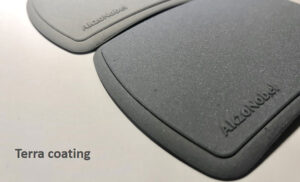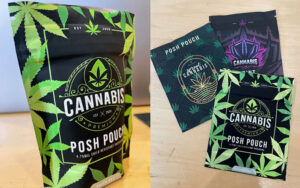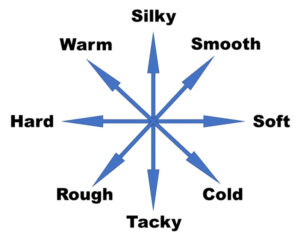by Paul Uglum, president, Uglum Consulting, LLC
When considering decorated plastic, the appearance of the part or product comes to mind first. Fortunately, plastic decoration can provide more than visual properties alone. It often is desirable that the finished part also have some level of tactile performance as well. Tactile surfaces are used to replicate the surface properties of other materials, to enhance desirability of less appealing surfaces, to improve surface feel of rigid materials, to create high-tech appearances and to add anti-counterfeiting features.
These surfaces are desirable in many markets, and studies show that the use of tactile and soft-feel surfaces increase the price premium of the product by 5% over traditional coatings by increasing the appeal and perceived value. Research also shows that buyers are more likely to purchase a product that is both visually attractive and engages their sense of touch. Soft-feel coatings and inks, either applied directly or through in-mold decoration, are the best way to achieve this result.
Soft-feel inks and coatings

Soft-feel surfaces can be realized using a number of decorating technologies and materials. Inks and coatings can be formulated to produce soft feel by using the composition of the resin, additives or with a combination resin and additives. Cure systems can be either thermal or UV (or a dual cure). For most soft-feel surfaces, low gloss levels also are desirable. This, in part, is because it is consistent with techniques used to create soft feel and because it matches customer visual expectations. In general, a soft, warm touch sensation that has a velvety or silky feel conveys a sense of a premium quality (Figure 1).
The choice of which technology and cure system are best depends upon both the intended end use of the product and regional constraints, such as government regulations or cultural preferences. Waterborne coatings often are required in Asia while solvent-borne coatings still are predominately used in Europe and North America. The decision for when to use an applied coating or an in-mold process often is dictated by the part’s geometry and expected production volume. There is no common solution, but there are many options to create a soft-feel surface.

Using a combination of processes that apply both rigid and soft feel on the same part is particularly effective in producing desirable outcomes. This creates contrasting appearances and feel – the use of high-gloss rigid with low gloss soft-feel, for example.
The more traditional soft-feel coatings companies, like AkzoNobel, have developed a series of soft-feel materials that include some level of additional texture. The family of Terra coatings, for example, provide an additional 3D color effect and unique texture touch feelings (Figure 2).

Demand for soft-feel and tactile surfaces covers a broad range of markets, from automotive interiors to advertising promotional items. Soft-feel surfaces are favored for electronics, including laptops, gaming products, computer mice, cellphone housings and high-tech electronics. Soft feel also finds uses in many consumer products, including appliances and household utensils. Ultimately, anything that is held or touched can benefit from soft-feel surfaces. One particularly strong growth area is in improving shelf appeal and perceived value. This can be done in packaging for products ranging from high-end cosmetics to cannabis (Figure 3).
Quality expectations always have dictated that the coating (or printing) meets high standards for visual and durability requirements. As a result, additional constraints, beyond creating the desired feel, need to be met to satisfy end-use expectations.
Automotive is a particularly challenging market, with significant durability and very long-life expectations. Early attempts at soft feel led to customer dissatisfaction due to chain scission caused by hydrolysis of early formulations. This manifested itself into a tacky coating and poor adhesion. One set of retained parts stored in a dark, dry environment showed similar issues after a couple of years, so hydrolysis testing alone may not be adequate. In addition, the early soft-feel paints tended to stain and lose their attractive feel over time, resulting in customer dissatisfaction. Generally, the more rigid soft feels do better in this environment.
Evaluating and measuring soft feel

Just as appearance cannot be defined by the measured color alone, the tactile feel cannot be characterized easily with one measurement. Unfortunately, unlike color and appearance, one of the problems faced in characterizing soft-feel coatings is having no industry-recognized nomenclature or defined technique for characterizing soft-feel surfaces. Tactile surfaces generally are described in terms of things known to be soft, with terms such as “velvety” or “silky.” An alternative model uses opposing characteristics, such as cold-warm, hard-soft, smooth-rough and silky-tacky. These also fail to capture the true nature of the surface (Figure 4).
The problem is exacerbated by the complex nature of how humans feel objects. The nerves, or haptic mechanoreceptors, in skin are sensitive to differing stimuli. Senses vary from form, texture, motion, vibration, temperature and even force. The mind integrates these into the perception of what the surface feels like. In addition, visual appearance and tactile feel often are linked. This is one of the reasons that studies are conducted with the participants unable to see the surface they are evaluating.
Since perceived “feel” varies from person to person, the best way to choose among options is to use clinics with typical end users to review options. The needs and expectations of each business segment is different. For packaging, the goal is to engage the visual and tactile perceptions of customers. For the automotive, a less soft and more robust soft feel is required. No one “feel” is ideal for meeting the needs of all markets.
After the target value is chosen, it is best to have a small group or individual evaluate candidates to the established standard. Feel is extremely subjective, and even with trained observers, there will be variations. In the case of visual comparisons, trained observers will incorrectly identify identical surfaces (cut from the same plaque) as not matching up to 18% of the time when the differences in the part set are small. The error rate for tactile evaluation is most likely higher. If a standard is being used to control processes, the condition of the observers’ hands, the care and storage of the standard must be controlled.
Human perception is unendingly complex. The shape of the surface to which the soft feel is applied also impacts the perceived feel. For example, packaging that has soft feel on both sides feels softer and more desirable than the same soft feel on just one side.
Several companies have developed optical, mechanical and analytical tools to evaluate touch surfaces. These are available because of improved understanding of both the biological and physical basis of tactile perception and research in robotics. They use differing priorities and models, but seem effective in differentiating and evaluating surface feel.
The Polymer Competence Center Leoben, GmbH has a focus on the physical surface and the material parameters, as well as the touch interaction with them. The Center uses an artificial finger to evaluate the surface. The topography, friction, vibration, pressure distribution, heat transfer, skin moisture and contact area are all evaluated.
SynTouch, Inc. also uses an artificial finger system to evaluate tactile feel. The company measures 17 parameters related to friction, texture, adhesive properties, thermal properties and compliance (properties like deformation, damping and yield). The results are presented in a spider plot format so comparisons between surfaces easily can be understood. The SynTouch website has several studies that include fabric and automotive interior components.
There is no universal agreement on which characteristics to include, but all agree that it is an integration of many characteristics. The surface topology of the coating and the physical properties of the polymers are very important in determining how soft-feel coatings are experienced and seem to be the most commonly controlled variables.
Risks and challenges
The increased focus on a circular economy and issues of both production waste and recycling present significant challenges to all decorated plastics products. The demand for sustainable packaging is growing dramatically. This, in many ways, runs counter and creates additional issues to the integration of all forms of secondary operations that apply decoration to products. Decoration must be both durable and easily recycled. The resulting risk can take form in legislative action and customer-driven desires for more sustainable options. It also can take the form of unexpected failure modes when using new bio-based substrates and reprocessed polymers. These may have the desired physical properties but behave differently from current materials in response to coating and decorating processes.
Durability issues also remain important. Stain resistance often is the hardest durability characteristic to achieve in soft-cure coatings. This is true even of the highly cross-linked UV-cured coatings. If staining is an issue, darker colors generally perform better.
Resistance to chemical exposure is a close second. Depending upon the market application, a wide range of cleaners, cosmetics, personal care products and even sweat will come in contact with the surface. In the case of automotive, even more aggressive chemicals such as DEET and aggressive personal care products can be expected. Because the environment continually is changing, both commercially and technically, it is good to continuously evaluate and reduce the expected risks.
Tactile outcomes beyond soft feel
Tactile surfaces are a form of functional coating that add value by providing haptic feedback when touched. These tactile surfaces can take many forms. They can incorporate texture or printed structures to replicate surfaces such as wood grain or leather. They also can create new structured decorative surfaces not otherwise possible.
Depending upon what tactile outcomes are sought, there is an ever-increasing set of technologies to meet the market needs. Just a few of the options include the following:
- Digital ink jet can create tactile features applied directly to the surface.
- Molding tooling texturing – The availability of very fast q-switch lasers has allowed reproducible and more complex surface texturing that can be combined with processes, such as galvanic plating, to create complex visual and tactile surfaces that have a cold feel.
- Both in-mold decoration and hydrographics now have improved options to create more complex tactile surfaces.
- Anti-fingerprint coatings used on display lenses are super hydrophobic and super oleophobic and, as a result, create a silky feel.
- Laser Marking – FOBA has developed a technology that allows additional security on identification and badging by creating both high-resolution images and tactile features on the same surface.
There are more possible options, so it is worth taking the time to investigate them.
Final considerations
An ever-increasing number of technologies and coatings are becoming available to achieve tactile and soft-feel outcomes. Take the time to investigate which ones will work best with the product or manufacturing process. Know both the strengths and limits of each technology. Organizations like the IMDA and SPE are more than willing to help and offer conferences and webinars on many technologies.
Regardless of what tactile effect is chosen, there are some important considerations. First, and most important, is to understand and communicate clearly what the expected outcome is, including color texture and feel, with the customer. Second, make sure there ia a clear understanding of how the product is expected to perform over time (both the initial performance expectations as well as the longer over-the-life expectations). Knowing these will enable decorators to choose the tactile surface that best meets the manufacturer’s and customer’s needs.
 Paul Uglum has 43 years of experience in various aspects of plastic materials, plastic decoration, joining and failure analysis. He owns Uglum Consulting, LLC, working in the areas of plastic decoration and optical bonding. For more information, send comments and questions to [email protected].
Paul Uglum has 43 years of experience in various aspects of plastic materials, plastic decoration, joining and failure analysis. He owns Uglum Consulting, LLC, working in the areas of plastic decoration and optical bonding. For more information, send comments and questions to [email protected].


